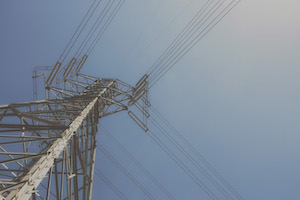Zelienople rare as electricity provider
ZELIENOPLE — Neighboring Harmony's real estate tax rate is more than twice that of Zelienople's. Just down Route 68, Evans City residents pay a rate four times higher.
Yet Zelienople's projected 2021 revenue — more than $11 million — dwarfs that of the two nearby boroughs. Population size and property value each play a role, but the biggest factor by far is the municipal electric utility.
Among Pennsylvania's more than 2,500 municipalities, just 34 provide electricity to their residents in lieu of investor-owned utility companies. Zelienople is one of these 34, and the only one in Butler County.
Diane Bosak, executive director of Pennsylvania Municipal Electric Association (PMEA), a professional group for these local governments, said there are a number of benefits, both financial and intangible, to public electricity.
“It does help to keep the taxes lower. It helps to fund different kinds of community and economic development efforts in all of the boroughs. It's a great resource,” she said. “And the electric department people, they'll also be helping out with other things in the community. It's time for Christmas decorations, right? They'll be out there doing that.”
Zelienople borough manager Don Pepe noted another advantage of the public system over a for-profit utility is the ease of access by residents to the utility provider.
“We're completely dependent on the citizens of (the) town. We know who you are and you know who we are,” Pepe said. “We respect the folks and they rely on us because there's a direct relationship that you don't get when there's an investor-owned system.”
It's certainly a rarity these days — but it hasn't always been.
A single bullet point buried inside the Sept. 28, 1905, Butler Citizen newspaper described the beginning of the process by which electricity came to Zelienople, as Elwood City's light company completed arrangements by which it would provide Zelienople with electricity for its own power system.Weeks later, lights strung up on Main Street by the Zelienople Light & Power Co. demonstrated its progress on electric infrastructure, and Edwin Meeder's store was the first to use electric lights, according to the Nov. 18, 1905, Butler Eagle. As the Eagle described it then, “electricity has struck Zelienople.”Zelienople Light & Power was a privately owned company. Its successor, Zelienople Electric Co., was established in 1911, and was similarly an investor-owned utility.But, Pepe said, somewhere along the line Zelienople acquired it — but no currently accessible records show if it was because the company was sold or if it had poor finances.“Whether they bought it or something, I'm not sure,” Pepe said. “We've owned that ever since.”At that time, public electric utilities were not rare. Over the coming decades, public electricity increased in scope, with more than 3,000 municipal systems in the early 1920s, according to the American Public Power Association.Of course, there were competing interests in the supply of electricity. Trolley companies had a compelling reason to own electric systems, and the trolley companies that provided service to the southern tier of Butler County were no exception.Harmony Electric Co. and Peoples Electric Co. were owned by the Pittsburgh, Mars and Butler Railway Co. — operator of both the Harmony Line and the short-lived Butler Short Line — and provided power to much of the region. Much like its railways, it was quickly apparent the electric companies were not as profitable as the company hoped.
As quickly as the public systems sprung up, however, they began to disappear.Municipal ownership dropped to 1,900 systems by 1930, according to the American Public Power Association. Similar consolidations occurred in and around Butler County, with municipal and even private utilities forming larger behemoths.In 1926, the Shenango Valley Electric Co.; Mercer County Light, Heat and Power Co.; and New Castle Electric Co. consolidated into the Pennsylvania Power Co. in midsummer.Two years later, according to the Butler Eagle, the Pittsburgh, Mars and Butler Railway sold its share in electricity to the Penn-Ohio Edison Co., whose officers were the same as Penn Power's.Subsequently, Harmony Electric and Peoples Power merged with Penn Power in May 1930, according to the winter 1975 Penn Power News magazine.While public power would balloon back up to 2,000 municipalities by the mid-1930s, it stayed around that number for the past 90 years, largely signaling the end of the road — much as Zelienople was once for the Harmony Line — for the proliferation of municipal-owned electric companies.
Every one of PMEA's 34 member municipalities is a borough, and there is no township or city within Pennsylvania that owns its own electric company, according to Bosak. That's largely due to what Pepe calls a “quirk” in Pennsylvania's legislative history: Only the Borough Code contains provisions on municipalities owning such utilities.While the two Township Codes permit such subdivisions to manufacture and sell electricity to utility companies via hydroelectric dams, the actual supply of electricity to residents is a power reserved for boroughs.Bosak suggested it's the age of the boroughs — “some of the boroughs are the oldest communities in some parts of the state,” she said — and that might be why they began offering their own electricity. And because they've been supplying that utility, it's become a part of the code.“It's not uncommon anywhere in the country, and pretty much every state there are municipal electrics. It's historical,” she said. “They've been there, they've had electricity as part of their portfolio almost from their founding.”Boroughs' ability to manufacture — although few do — and supply electricity has survived multiple revisions to the Borough Code. A few challenges have come up over the years, but have frequently been rebuffed.“We pride ourselves on the ability to be able to make that transfer (from the electric to the general fund) in order to be able to provide a wide range of services. Some people may disagree with that,” Pepe said. “(State) Rep. (Aaron) Bernstine (R-10th), for example, criticized it a couple of years ago, but I don't think he recognized the benefit of that.”
Zelienople's property tax rate in 2020 is 5.81 mills, of which it uses 2.81 mills for its general and recreation funds — the rest goes to the fire department and library.The public utility is “the reason why it's low. We don't rely on property tax to pay for how we operate,” Pepe said. “There's a huge benefit there, and the property owners don't get killed.”On top of that, Bosak said the PMEA boroughs are able to offer competitive rates. Zelienople, for example, charges an $11.03 monthly base charge for a single-family household, 8.5 cents per kilowatt hour for electricity and 8.63 cents per kilowatt-hour as a distribution charge for the first 1,000 hours, then the distribution charge drops to 7.98 cents.The rates for Penn Power, which supplies the surrounding municipalities, include an $11 monthly base charge, a generation charge of 6.477 cents per kilowatt-hour and a distribution charge of 4.437 cents per kilowatt-hour, according to documents with the Pennsylvania Utilities Commission.It's a higher rate than investor-owned utilities, Pepe said, but it doesn't reflect the full cost.“The rates are interesting, and here's something that people don't understand. Our rate for electric is a little higher than Penn Power's rate, for two reasons. The first is, our electric cost includes the transmission and all the things that go into that cost are reflected in our number. Penn Power, for example, some of the other investor-owned companies, don't reflect their rates the same way,” he said. “We put all of it into one, and that's our rate.”Additionally, he added, it's how municipal services are funded. Pepe described higher property taxes as regressive taxes that disproportionately affect senior citizens. With electricity, he said, residents can control their usage, whereas property values are largely out of owners' control.“It pays for your police service, it pays for your fire service, it pays for plowing your streets and, by the way, you're not paying it in property tax,” he said. “It's a big difference.”There are intangible benefits too, both Bosak and Pepe said. Pepe said the borough doesn't see its customers as “numbers,” and will work diligently to help people avoid shutoffs if they face financial difficulties. The borough also doesn't shut off electricity from November through April.Bosak said the workers see customers as their neighbors, and their work as having a bigger impact, rather than simply being a job.“Our communities pride themselves on response times if there's an outage. Their crews are right there, so they're able to move quickly and they're able to respond, get things back up and running,” she said. “You've got people who are vested. The crew and the supervisors that work in those departments really care about their communities.”













